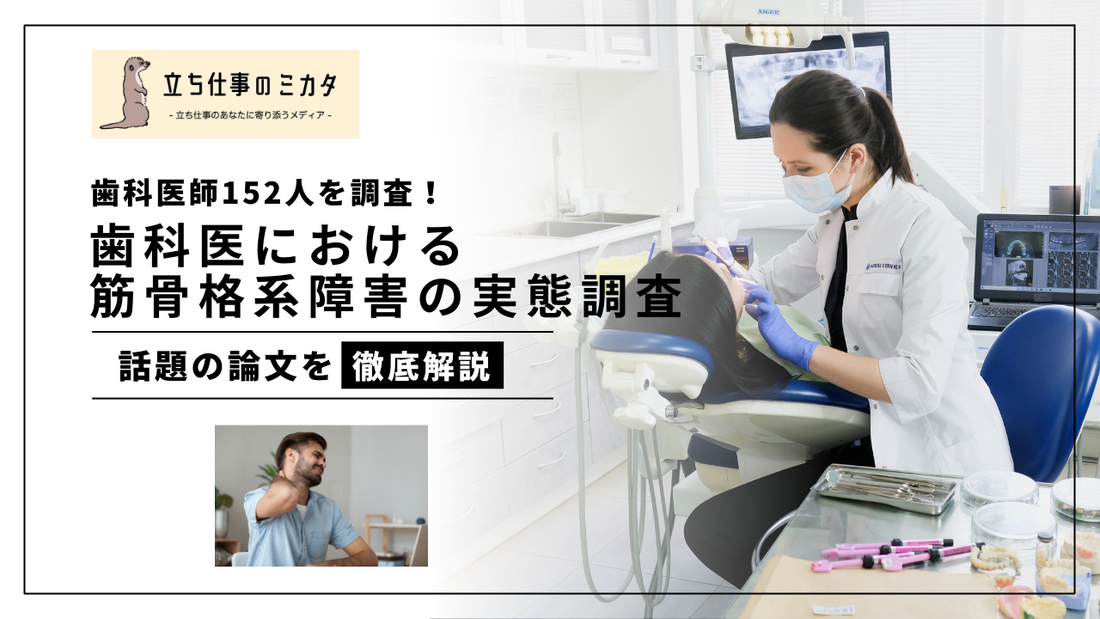
Survey on musculoskeletal disorders (MSDs) among dentists: What are the prevention and countermeasures?
Share
1. Introduction
Dentists are at high risk of musculoskeletal disorders (MSDs) due to long hours of work in the same position and repeated delicate manual tasks. In this article, we will explain the actual situation of MSDs among dentists and preventive measures based on the latest study, "Musculoskeletal disorders among dental practitioners - A survey."
2. Survey Overview
This study investigated the occurrence of MSDs among 152 Indian dentists (96 men and 56 women). The following information was collected and statistically analyzed:
- Height and Weight
- Average number of patients treated per day
- Number of working days per week
- Years of experience as a dentist
- The frequency and severity of pain or stiffness
The survey revealed that many dentists suffer from pain in their neck, shoulders, lower back, and hips.
3. Survey results: The actual situation of MSDs among dentists
1) Incidence of stiffness
Many dentists cited the following as areas where they feel constant muscle stiffness: From these results, it can be seen that neck, back, and hip pain were reported at a particularly high rate, and that poor posture for long periods of time is likely to be a factor.

② Pain intensity by area
The survey not only analyzed the incidence of pain, but also the intensity of pain (mild, moderate, severe). The frequency and impact of pain in each area is shown below.

The results show that neck (74%), back (69%) and hip (84%) pain was reported at a particularly high rate, likely due to poor posture for long periods of time.
Further analysis of pain intensity revealed a high proportion of dentists experiencing severe pain in specific areas.
- Neck: Severe pain 46% (increased risk of stiff neck)
- Back: Severe pain 56% (possible lumbar disc herniation)
- Hip joint: Severe pain 11% (affected by sitting for long periods of time)
As such, dentistry puts a great deal of strain on the neck, back, and hips, and can lead to long-term occupational diseases.
4. Why are dentists more susceptible to MSDs?
① Long-term static posture
Dentists must maintain the same posture for long periods of time during treatment, which reduces blood flow and makes muscles more susceptible to fatigue .
② Unnatural postures and repetitive movements
In order to check inside the patient's mouth, doctors often have to repeatedly lean forward and raise their arms in an awkward position , which puts a lot of strain on the shoulders, neck, and back.
3) Precision work
Overuse of the muscles in your fingers and forearms when performing fine motor movements increases the risk of MSDs in your elbows and wrists.
5. Measures to prevent MSDs among dentists
① Be aware of correct posture
- Position the patient appropriately to avoid leaning forward.
- Reduce strain by straightening your spine and relaxing your shoulders .
② Introduction of ergonomic equipment
- Use an adjustable treatment chair to optimize posture.
- Opting for lightweight equipment will reduce strain on your wrists and arms.
3. Stretching and Exercise
- Stretch your neck and shoulders between treatments.
- Stabilize your posture by strengthening your back and hip muscles.
4. Be mindful of rest
- Take short breaks every hour to relieve muscle tension.
- Use ice packs or warm compresses to reduce inflammation and pain.
6. Summary
This survey revealed that many dentists experience MSDs, especially neck, back, and hip pain . Maintaining proper posture, improving the work environment based on ergonomics, and making stretching and exercise a habit are important for preventing MSDs.
Does your clinic have any measures in place to prevent MSDs?
Review your daily habits and work towards a healthier work environment.
